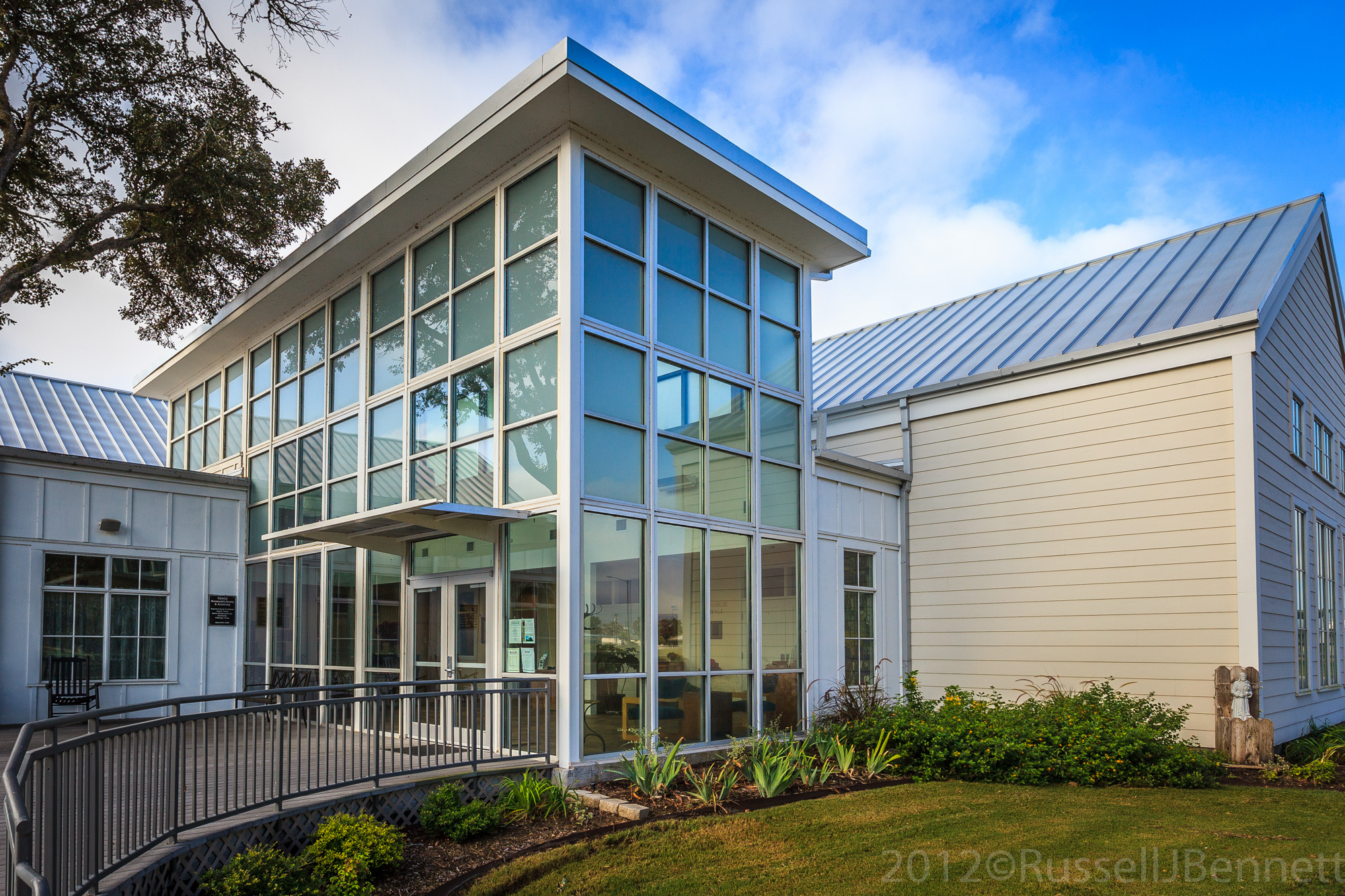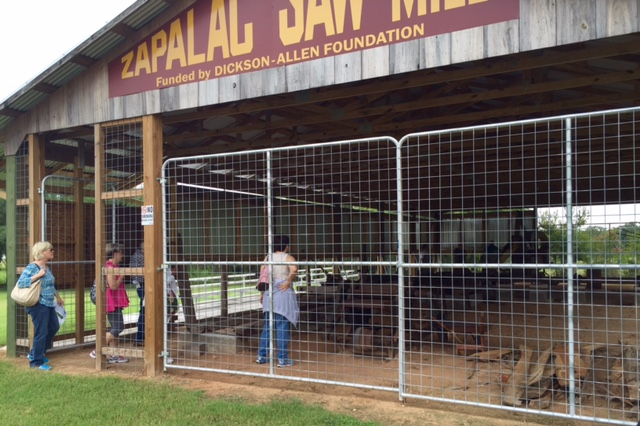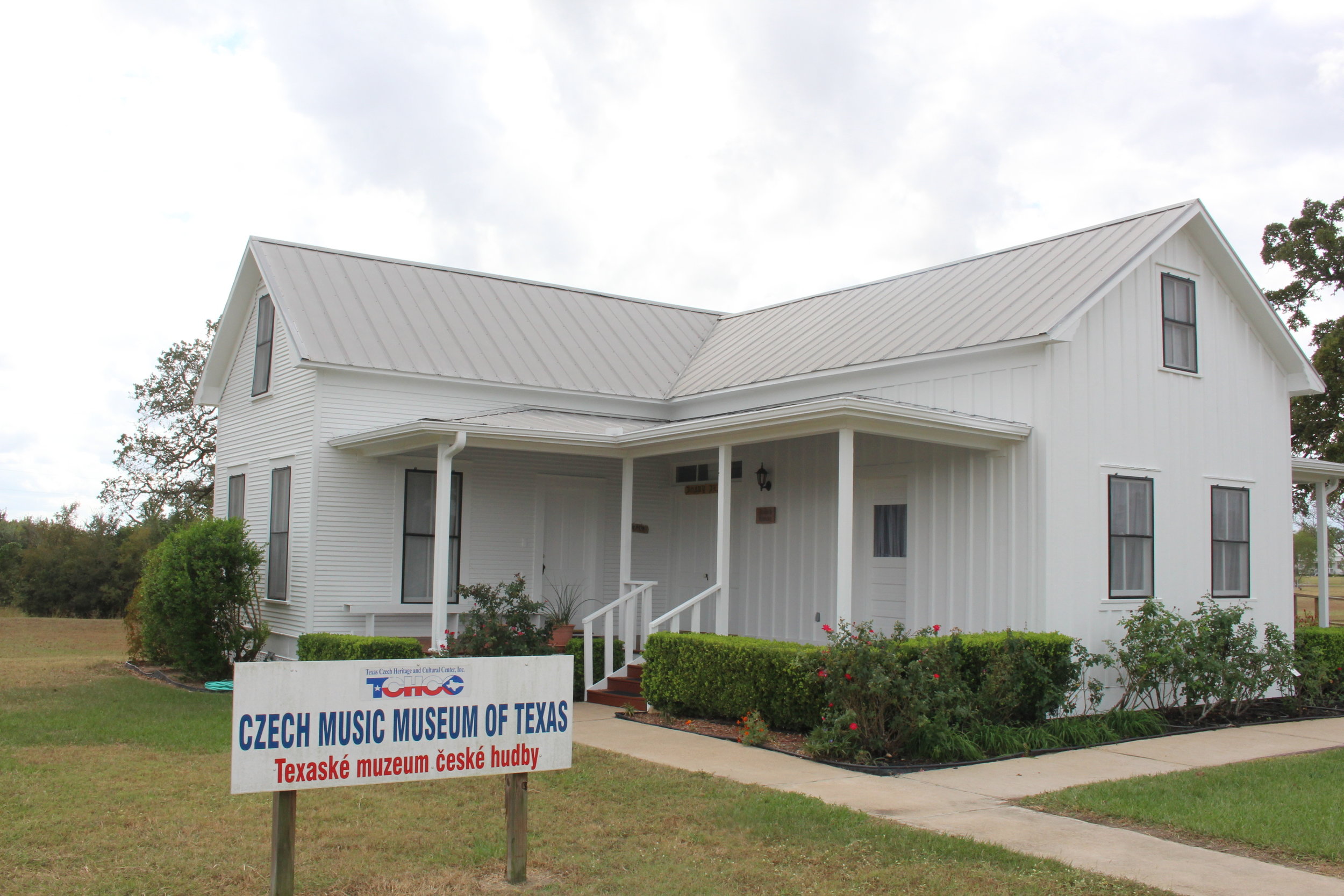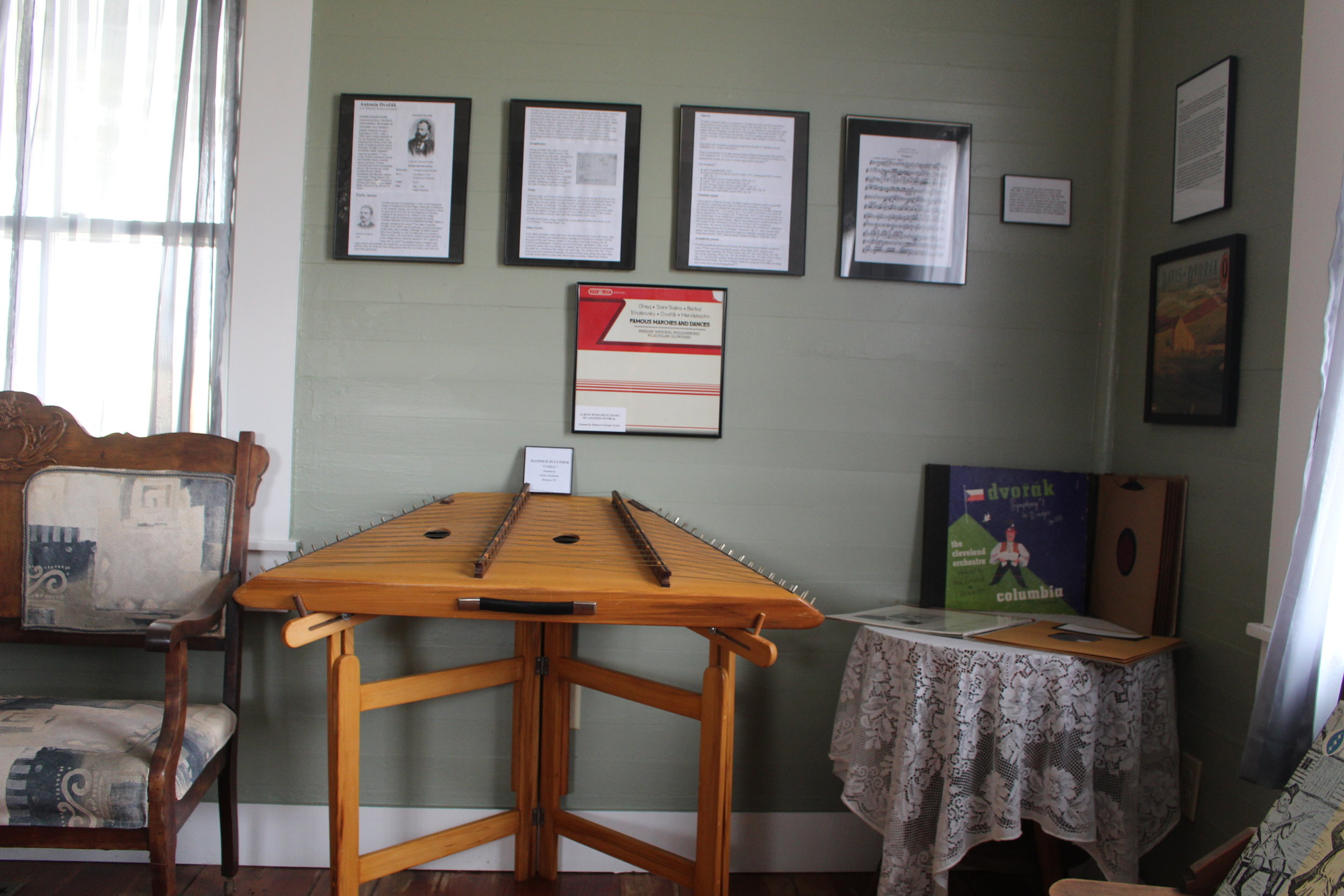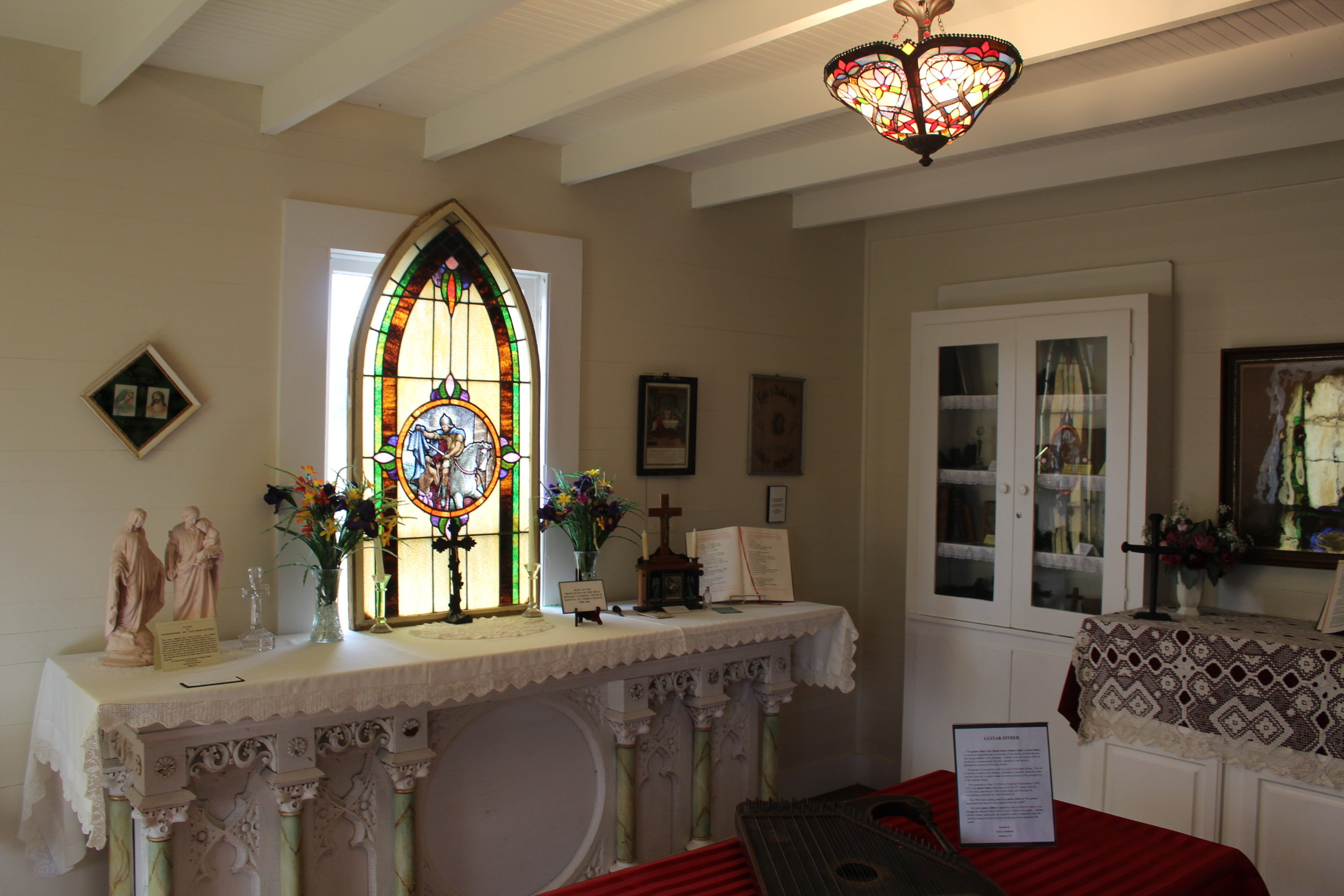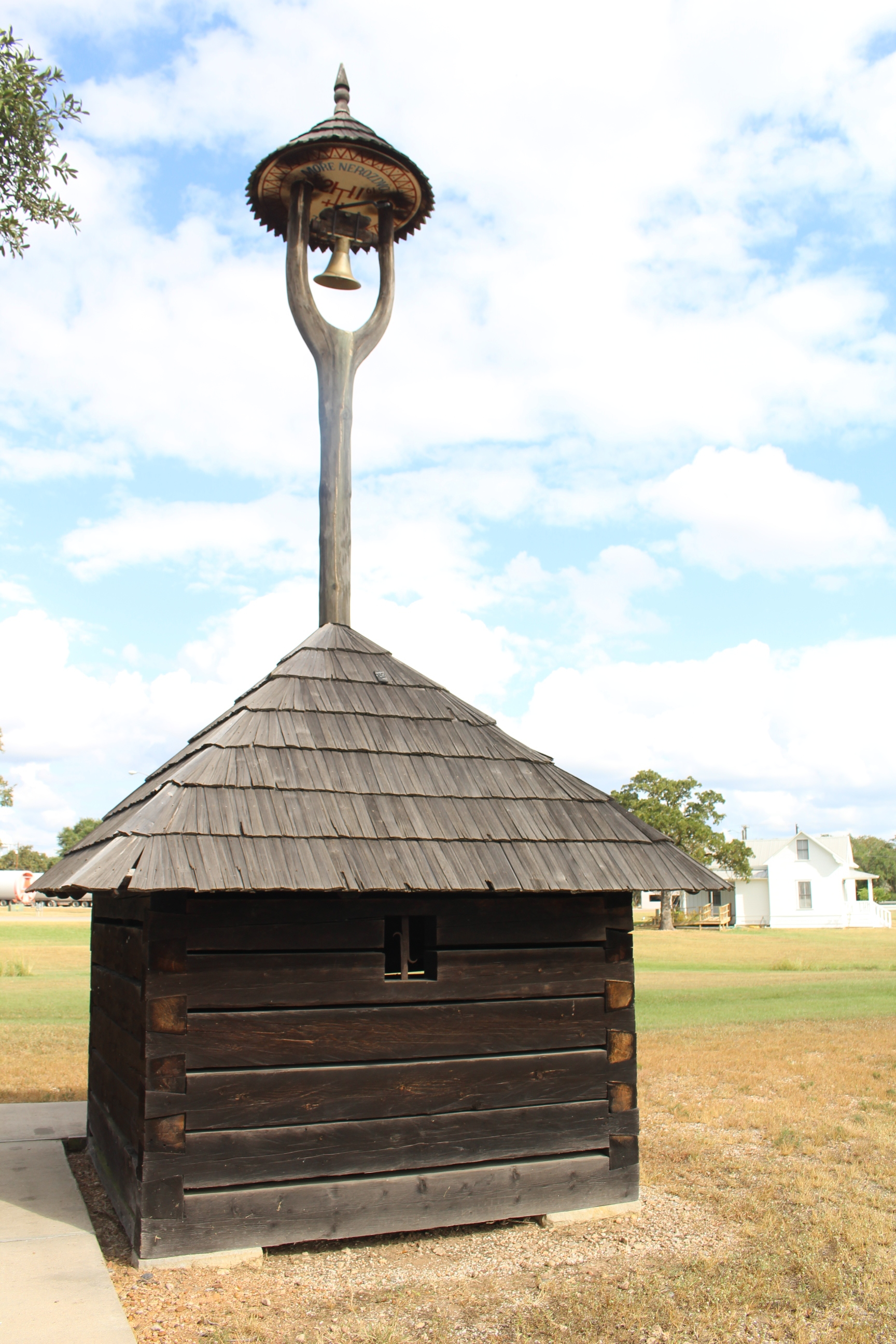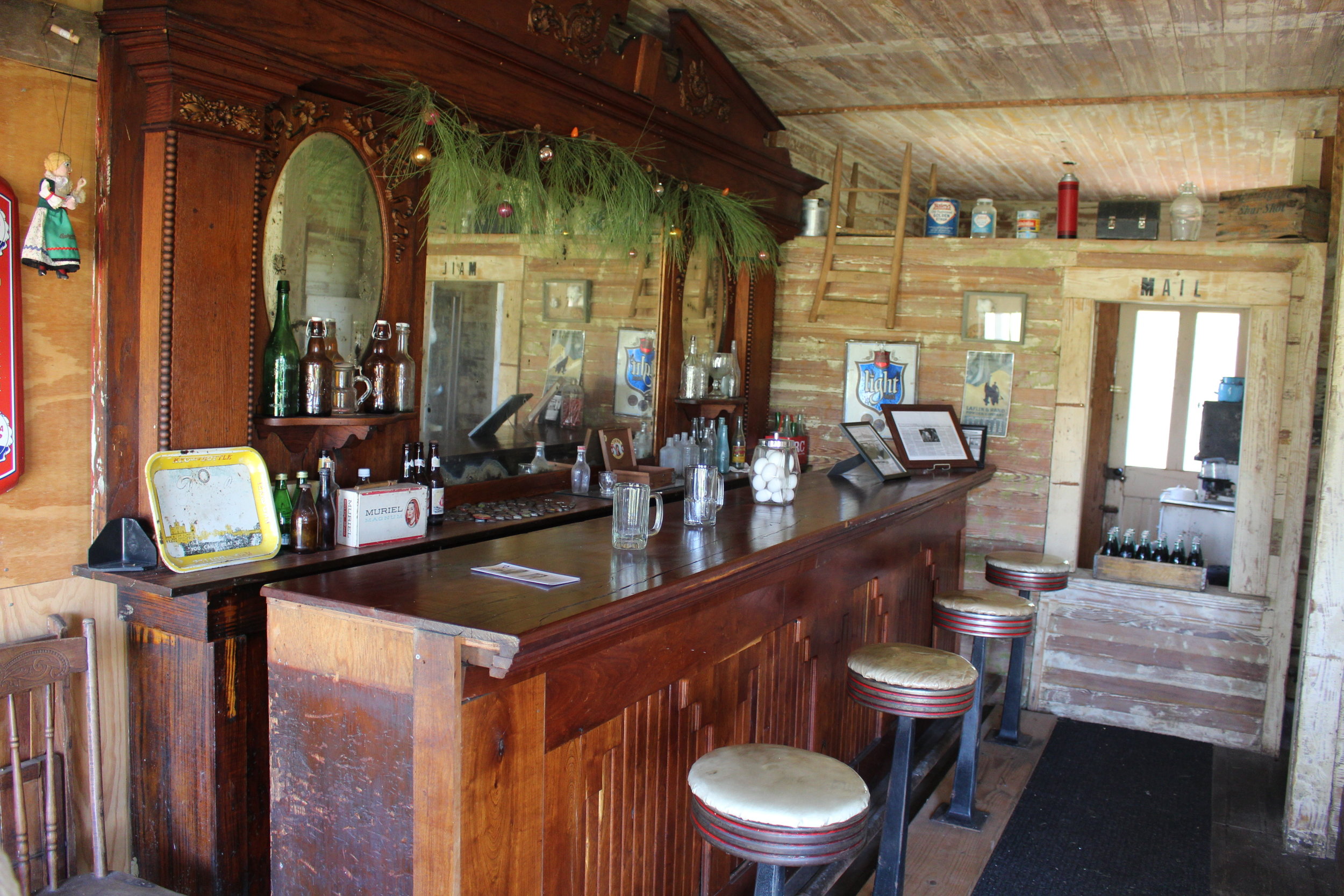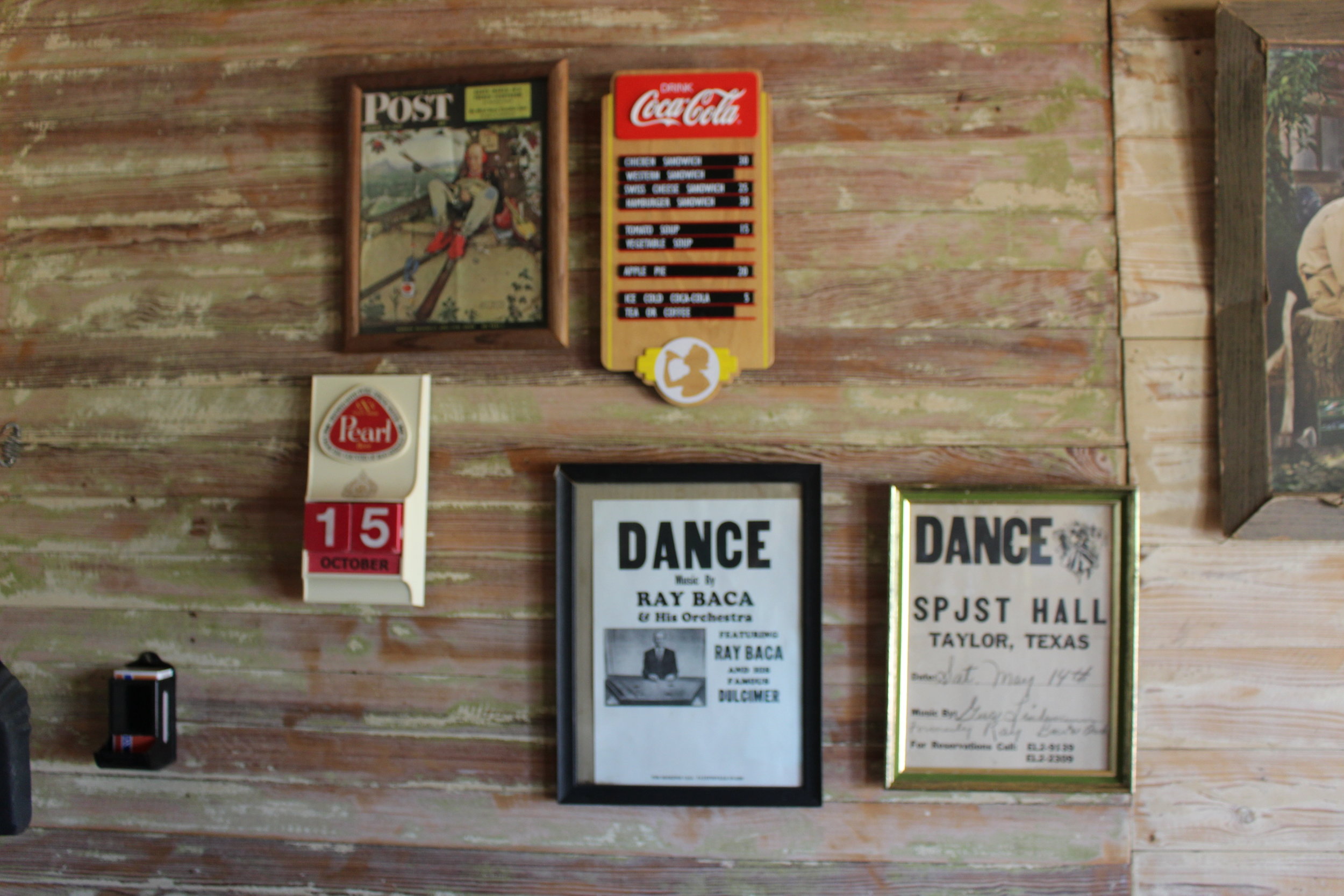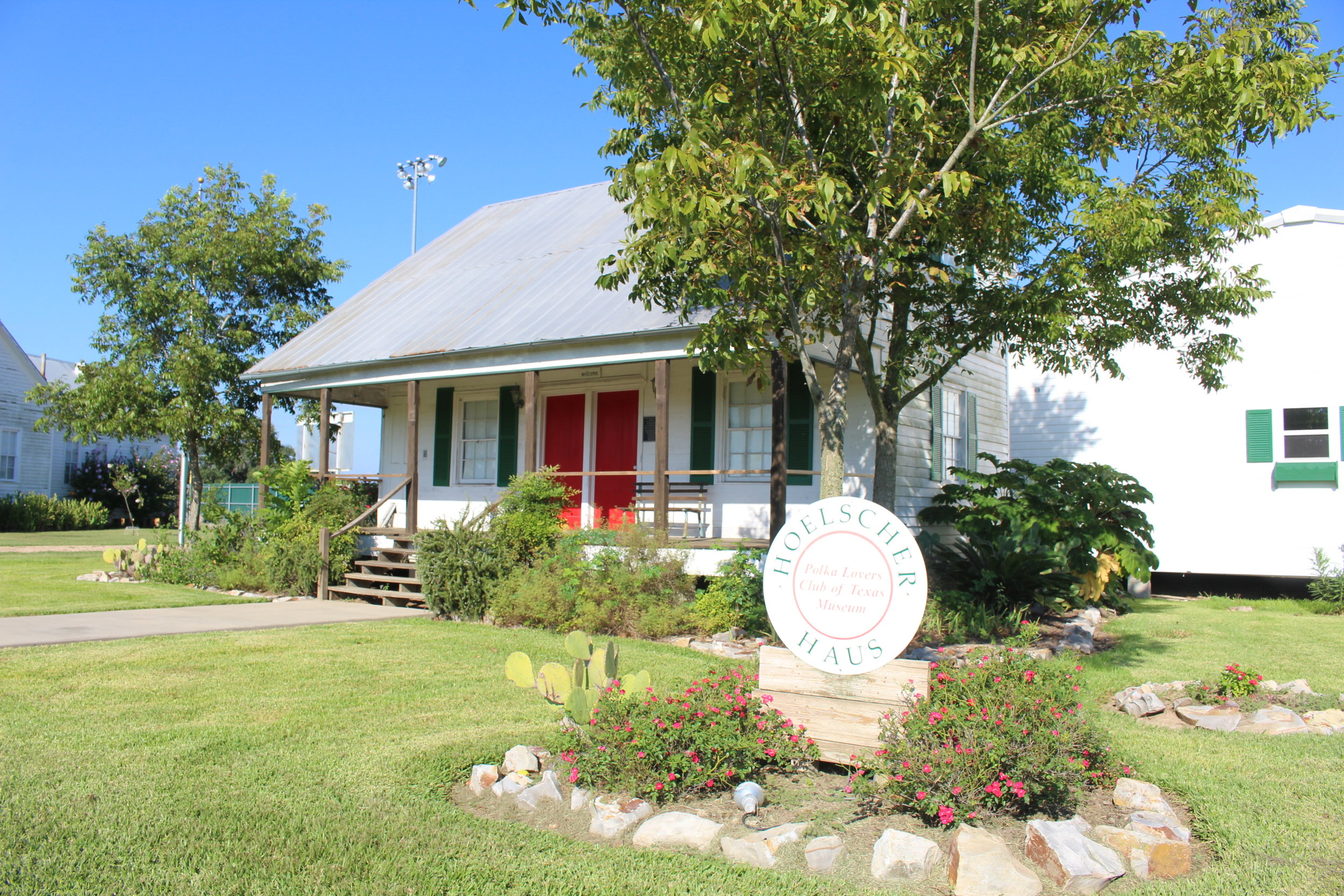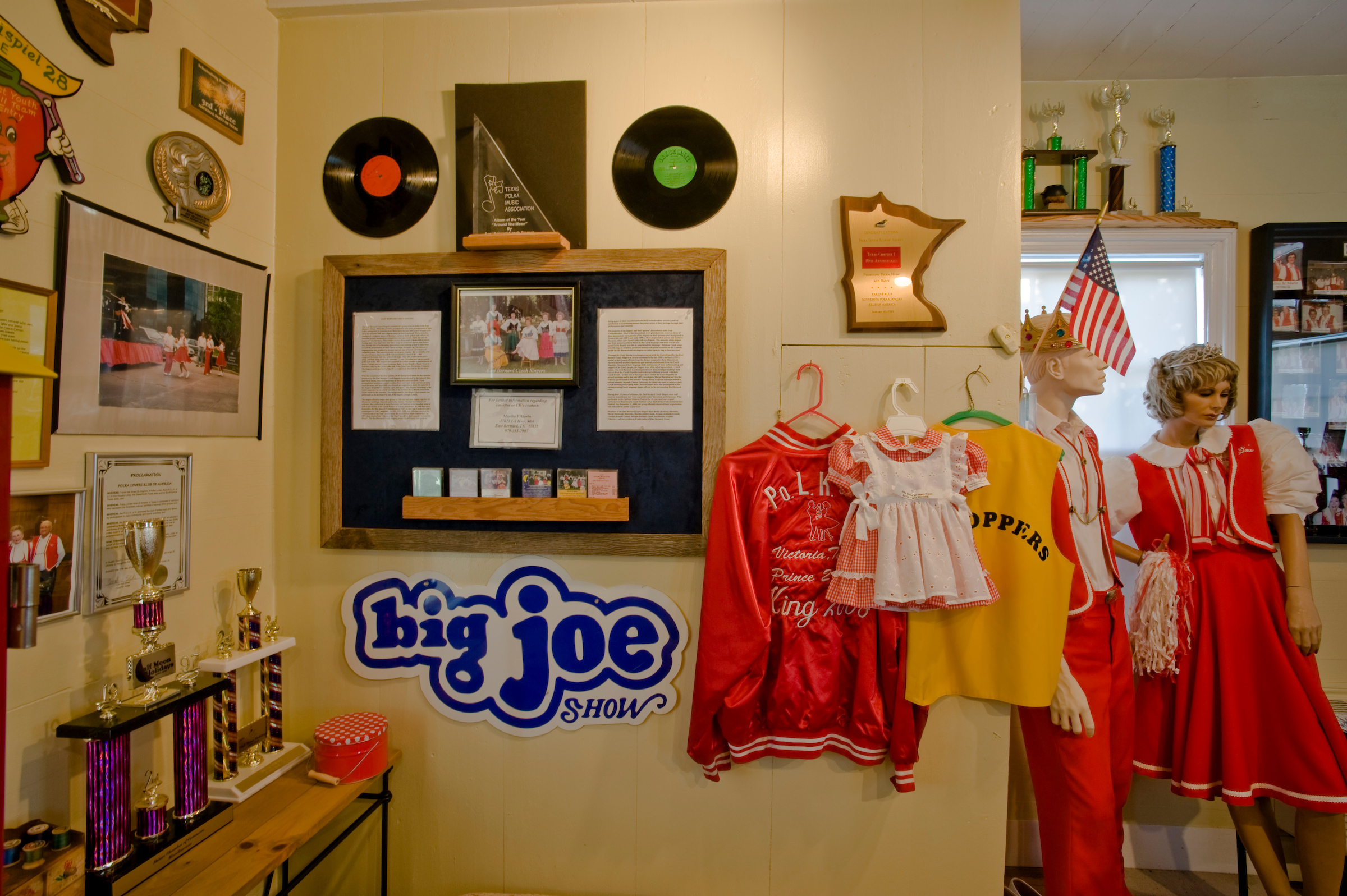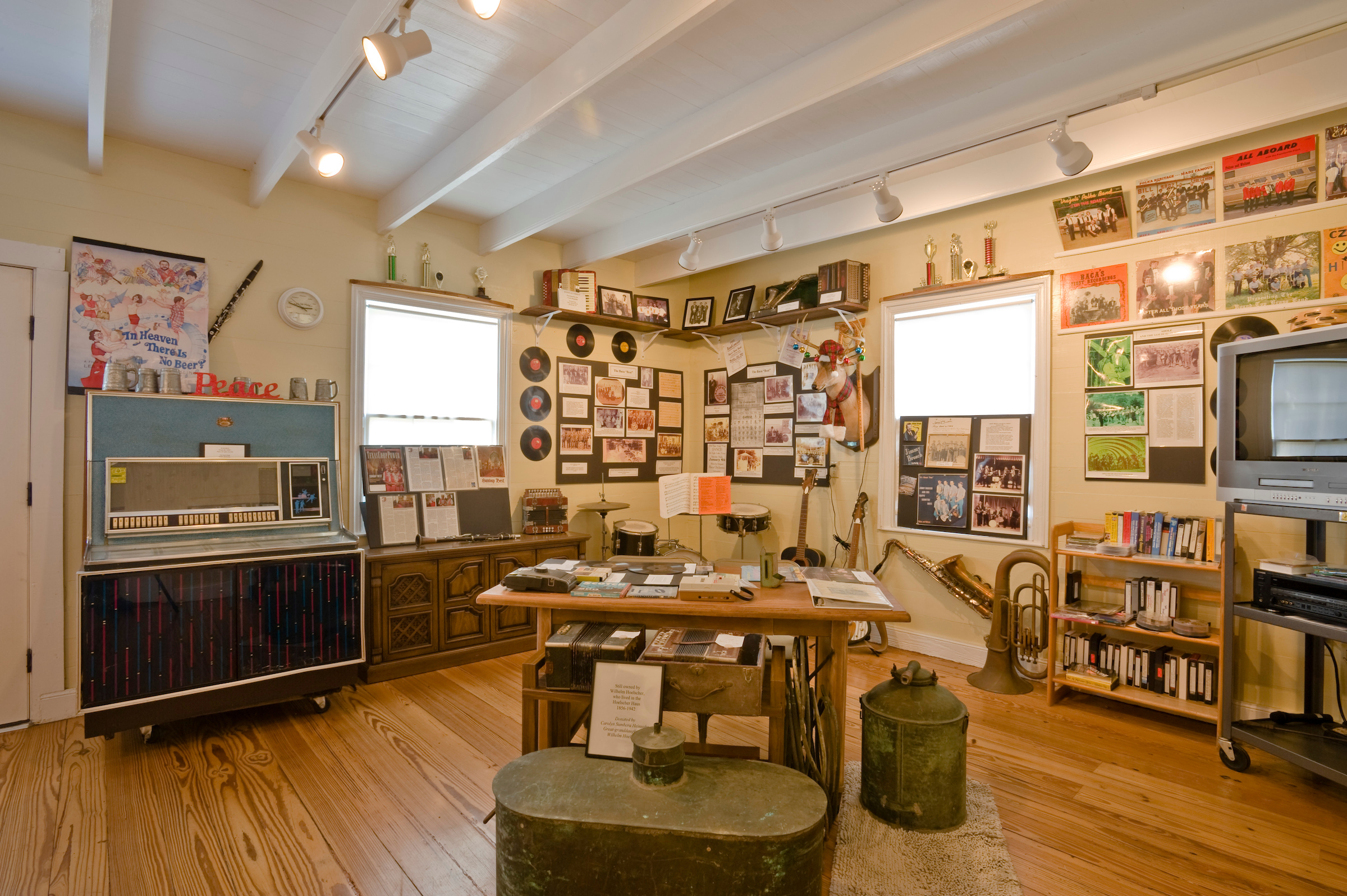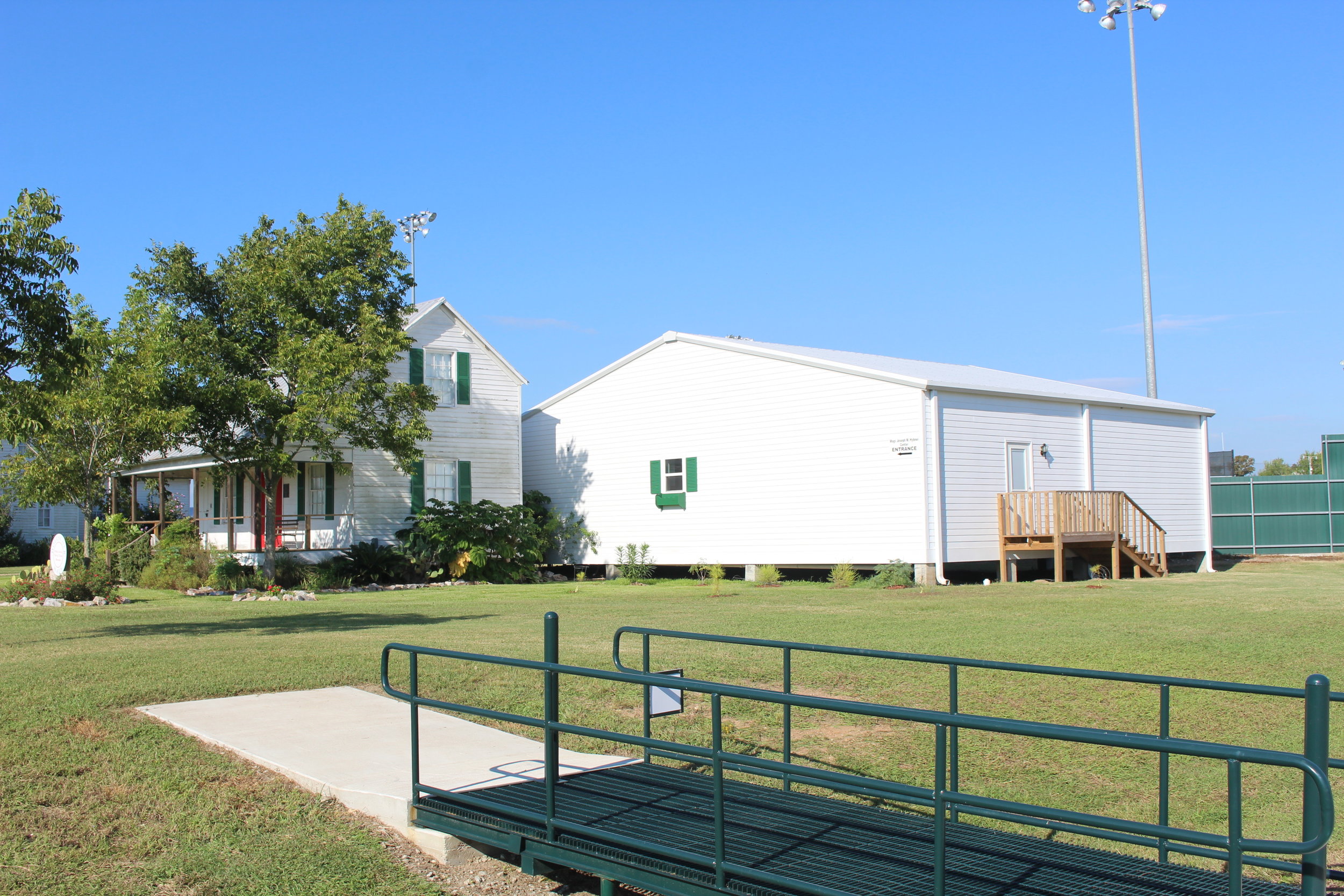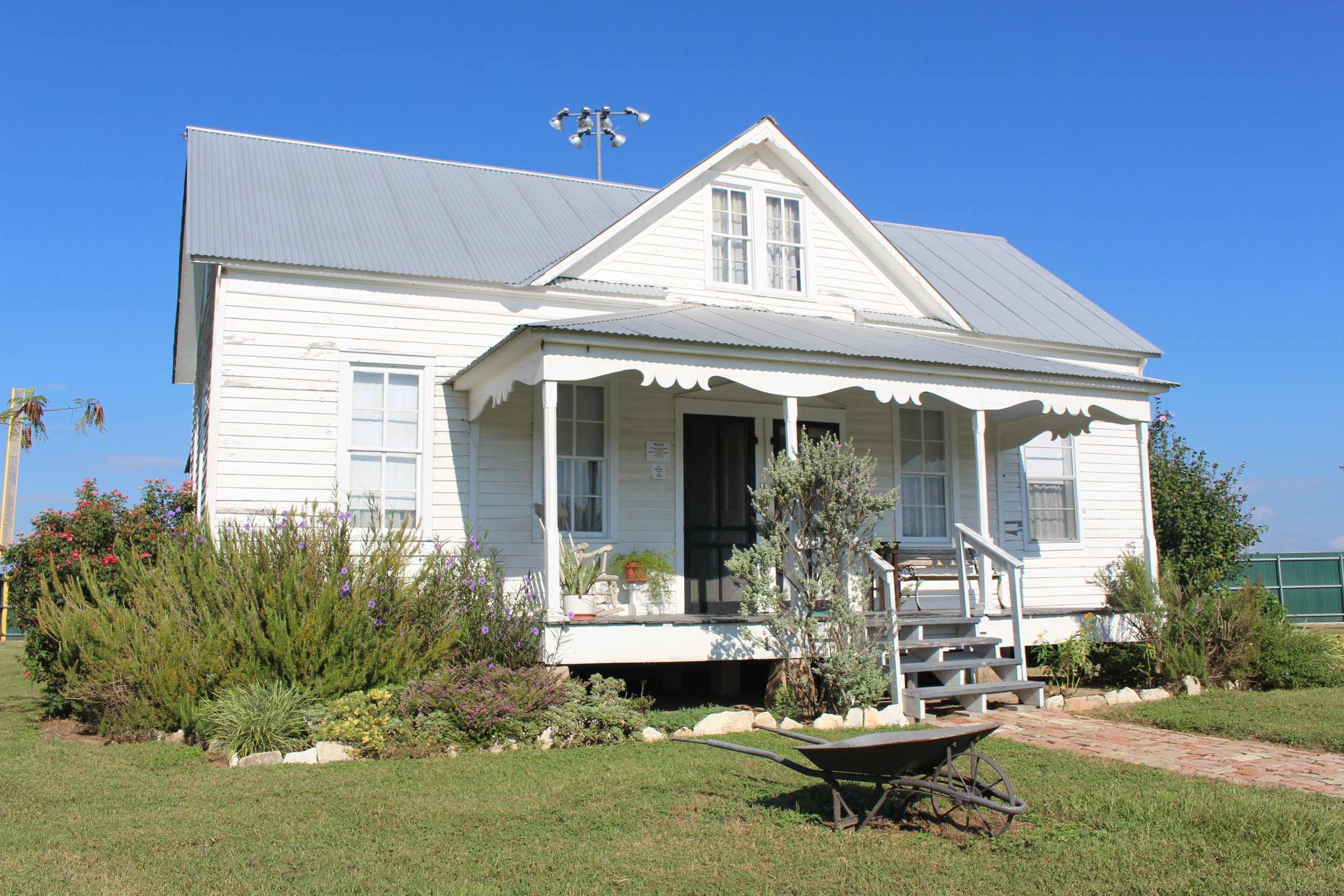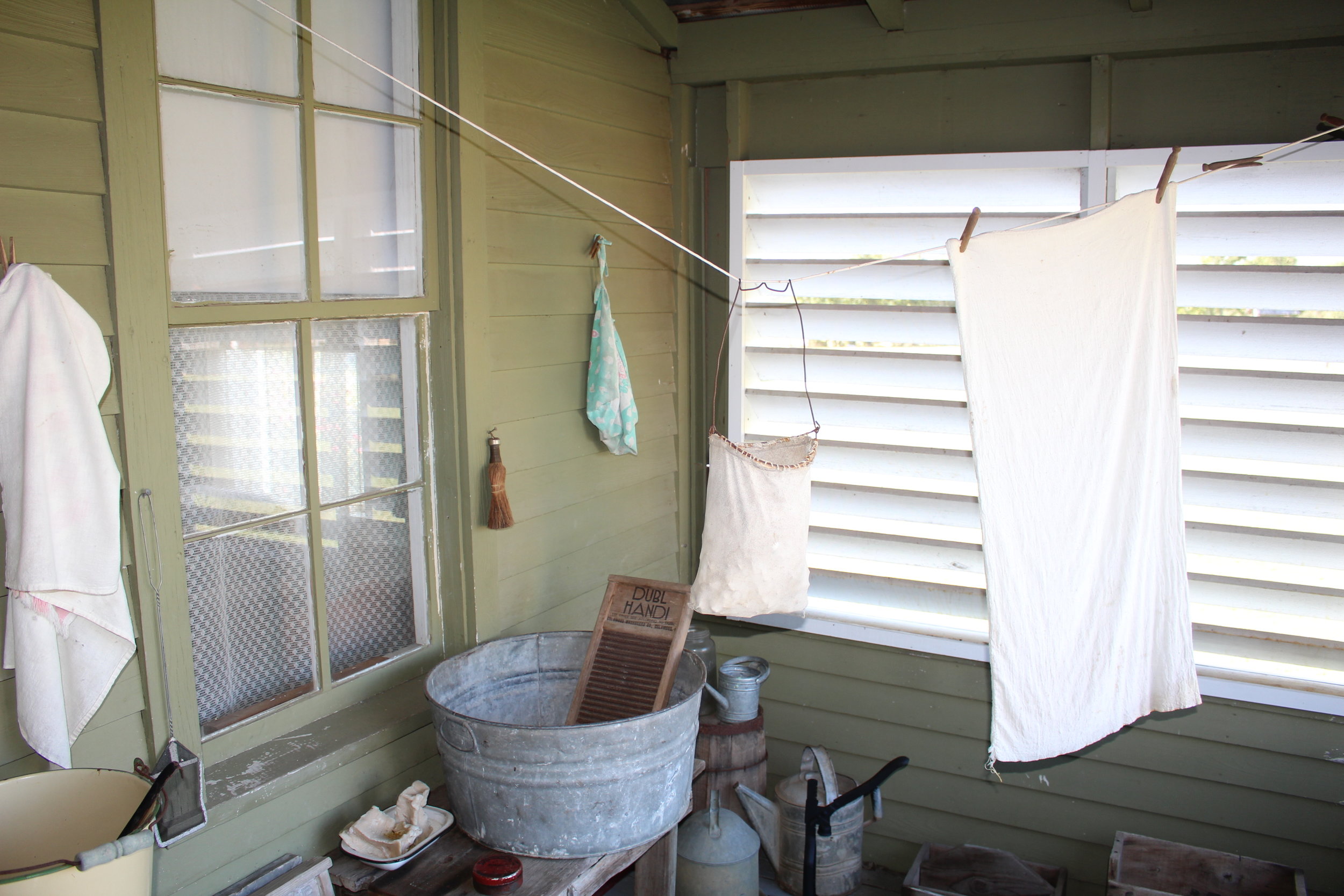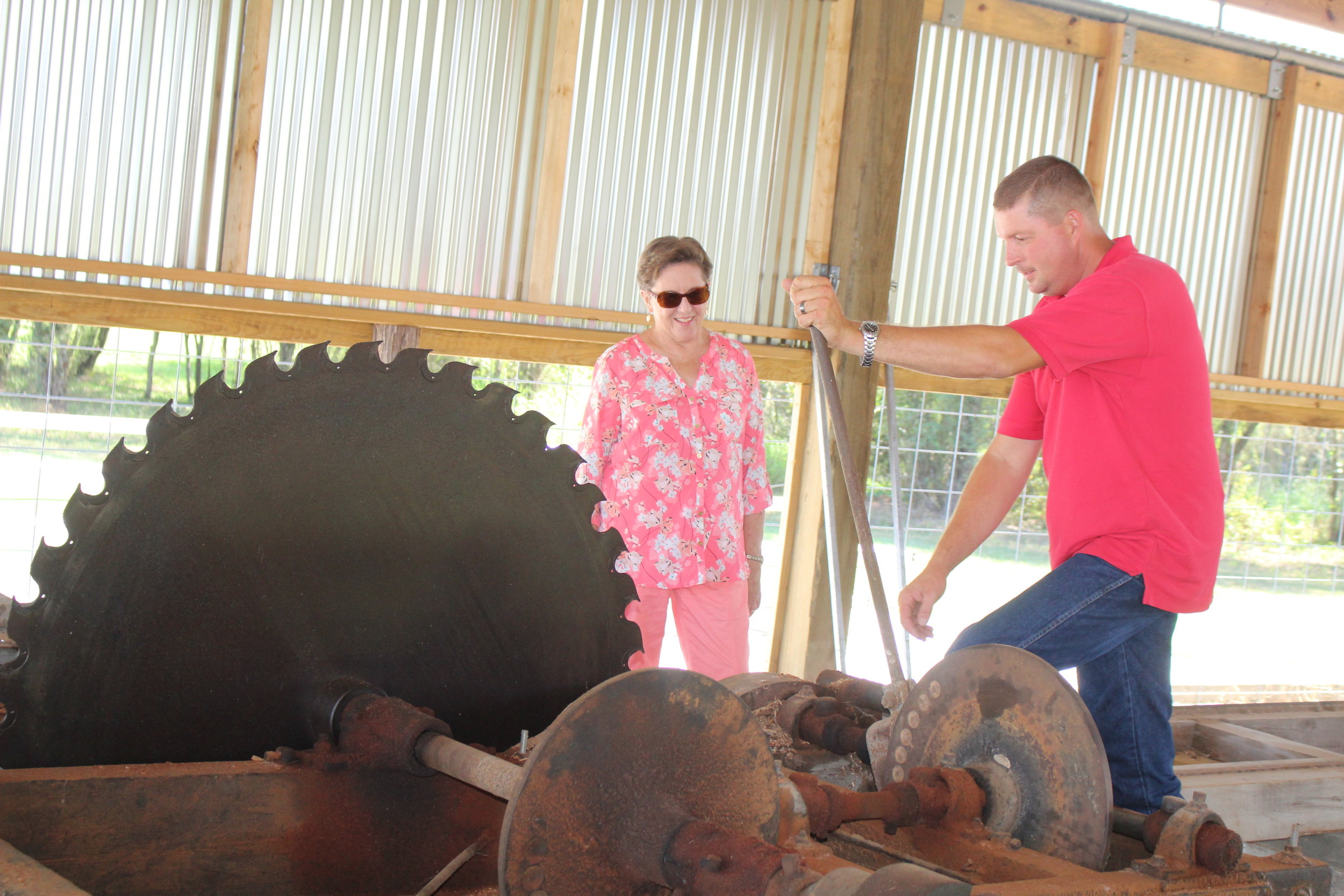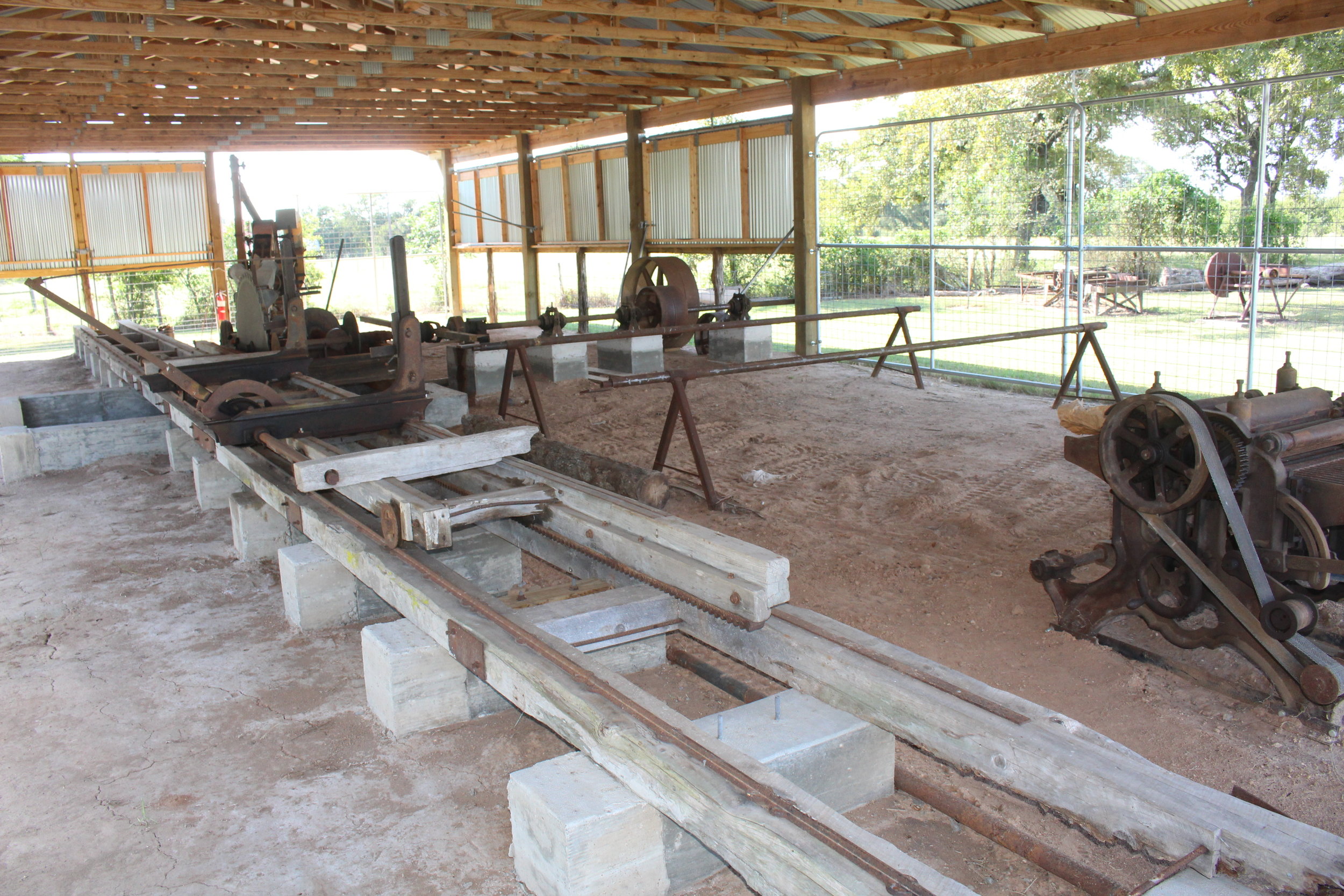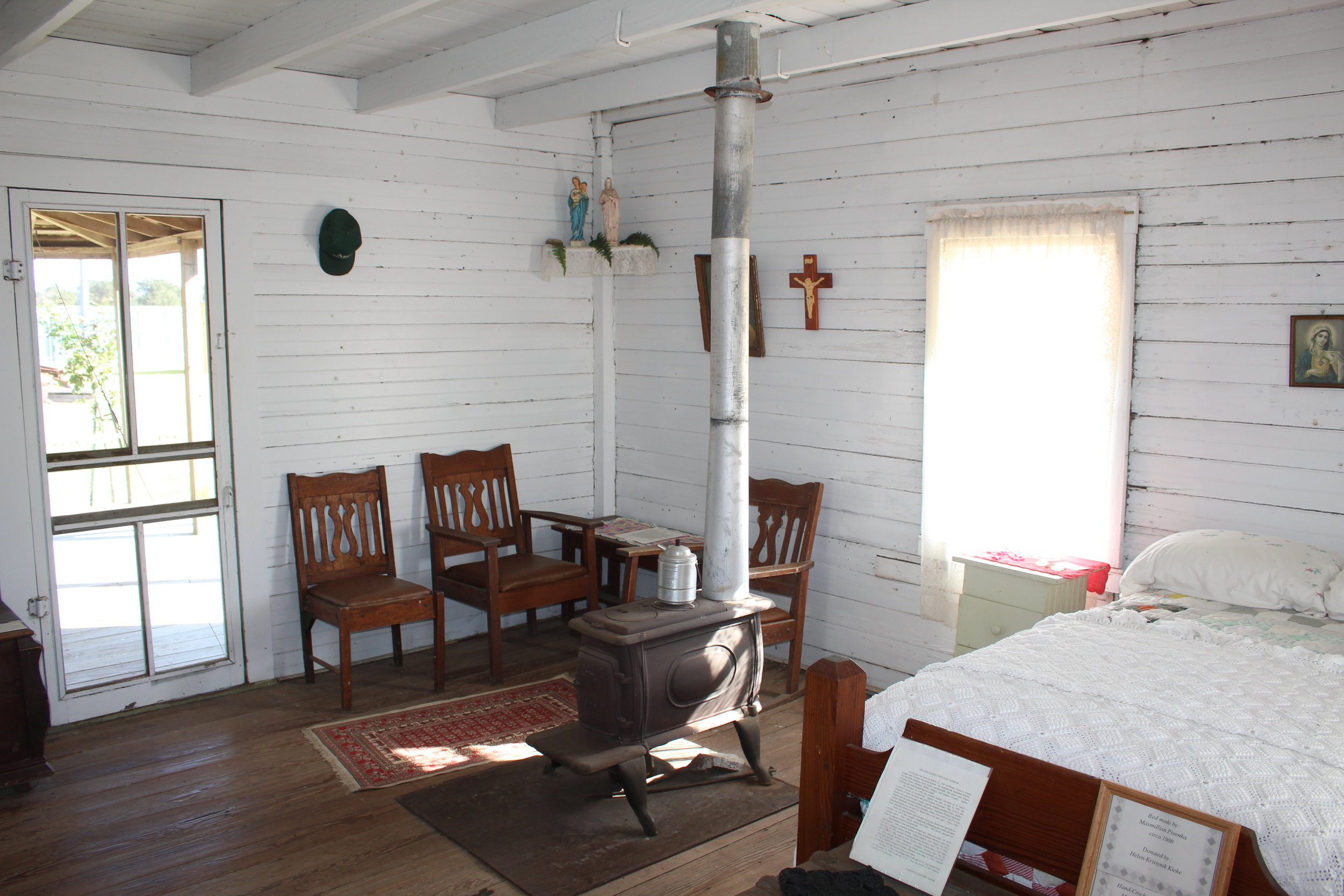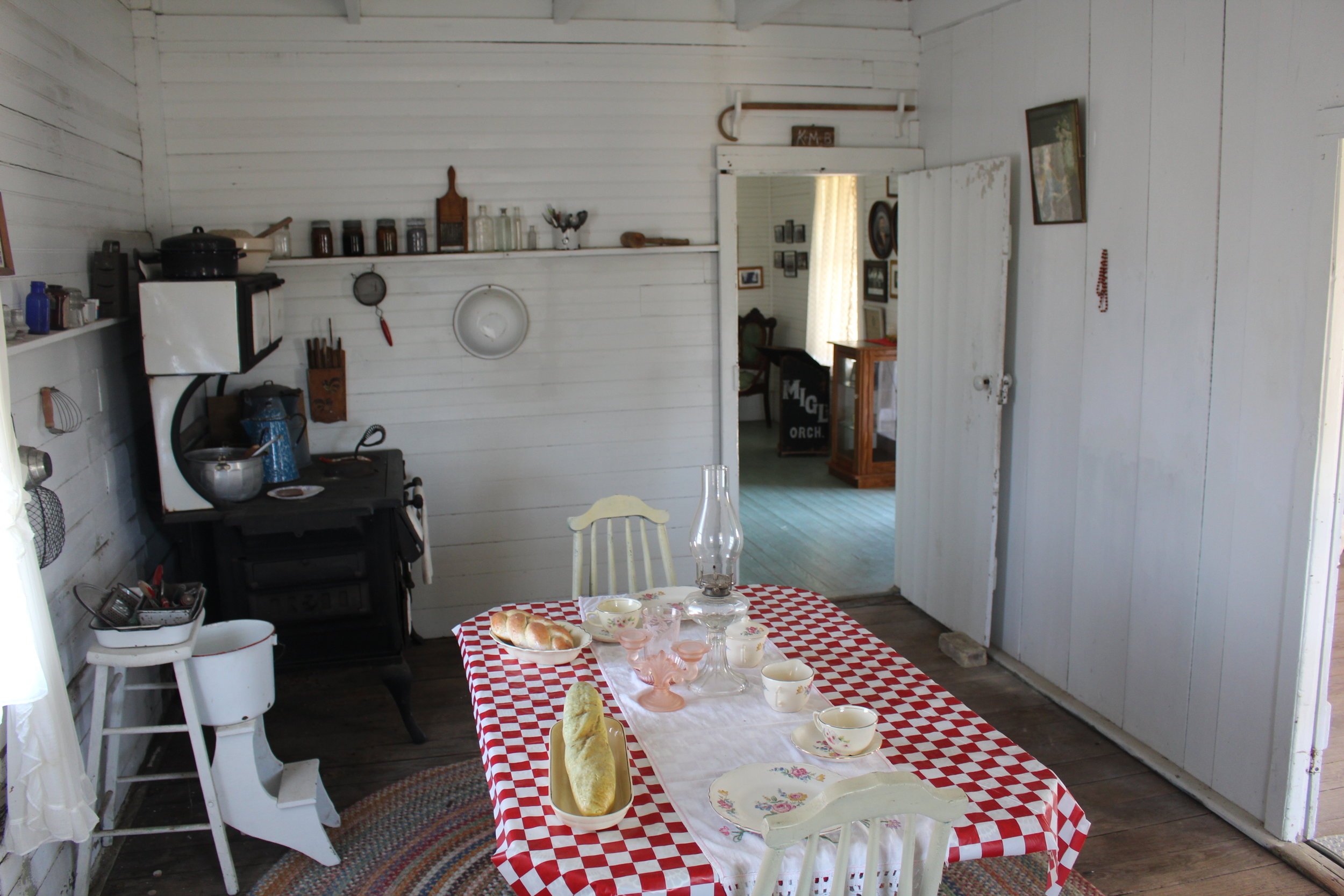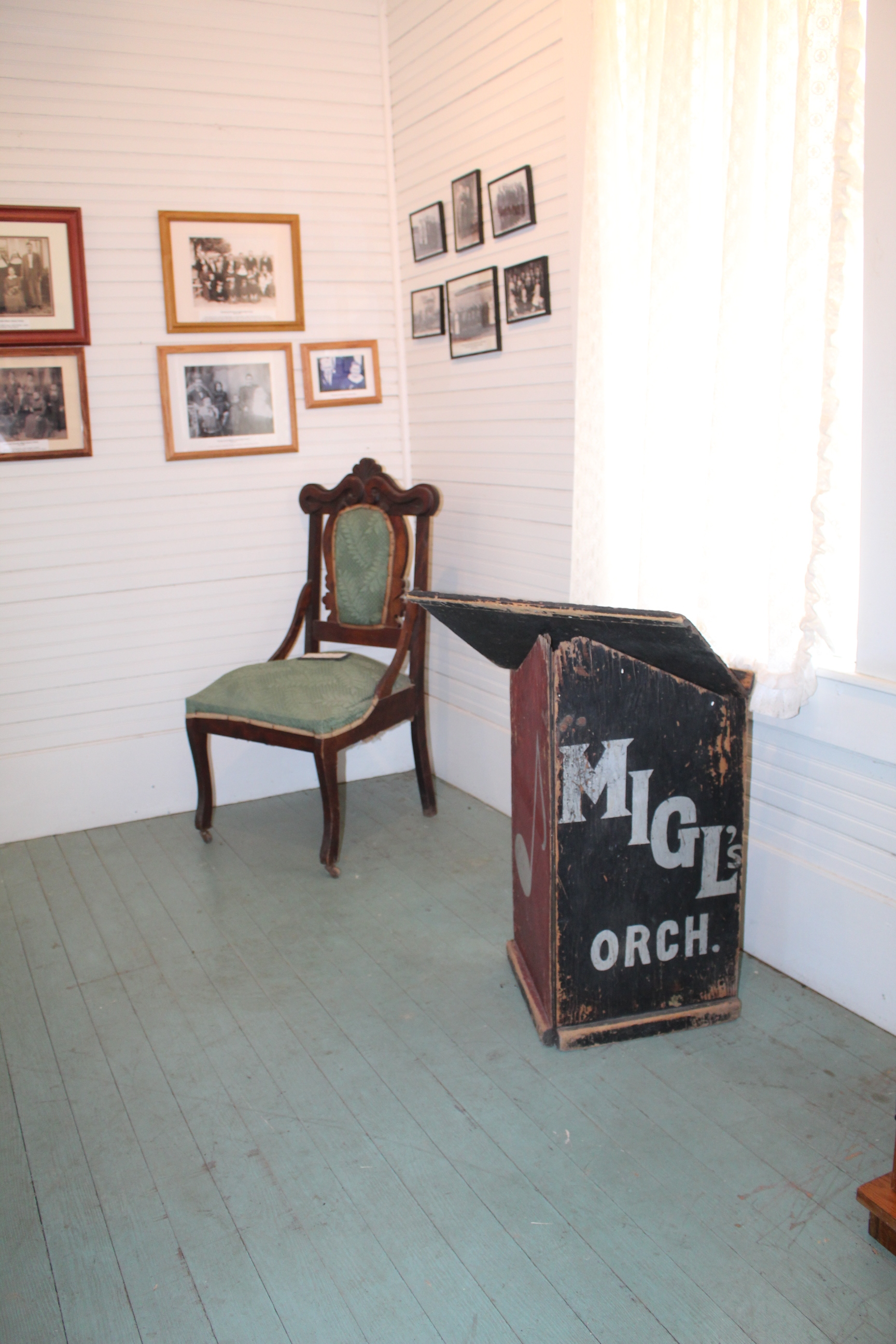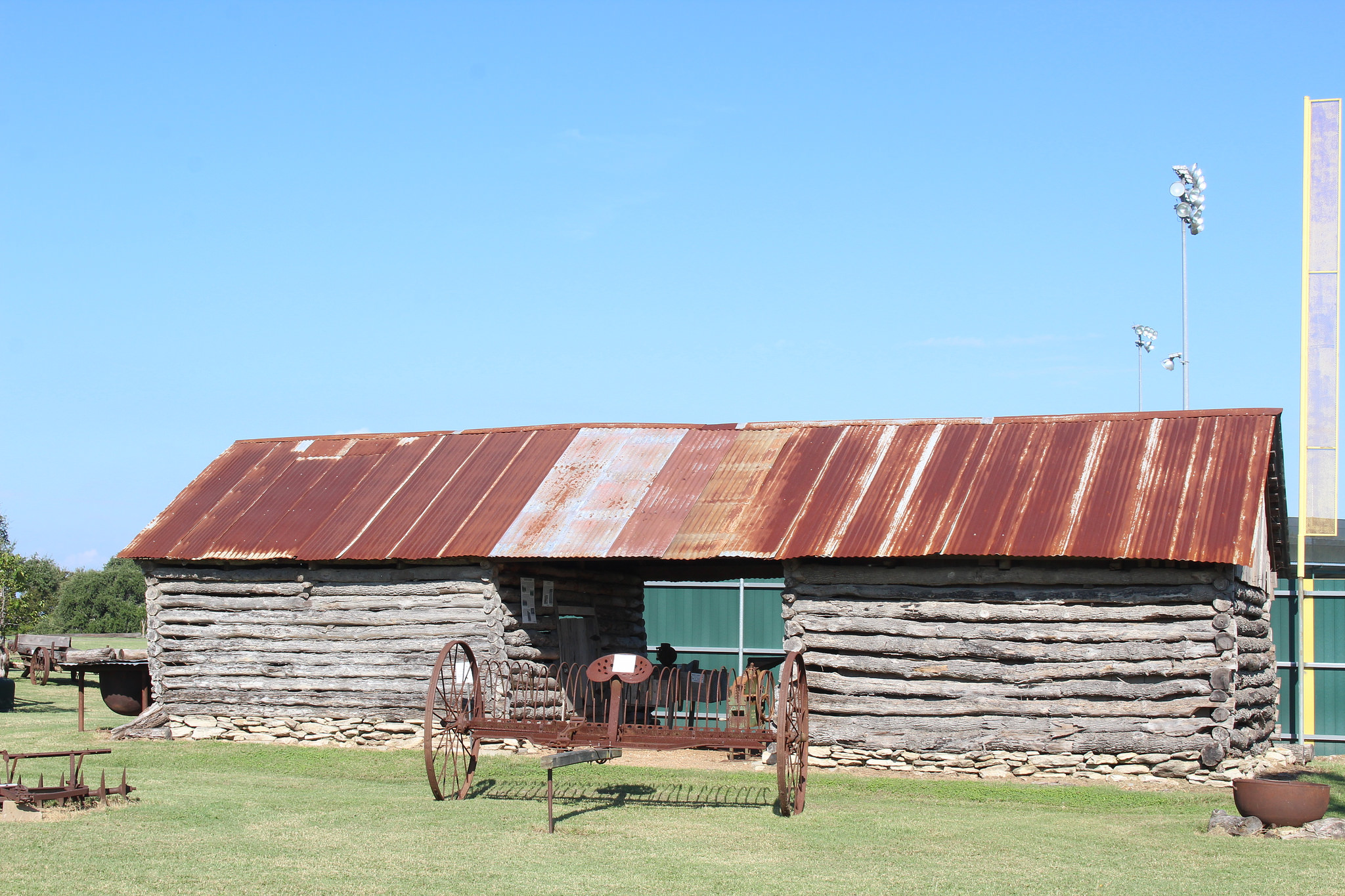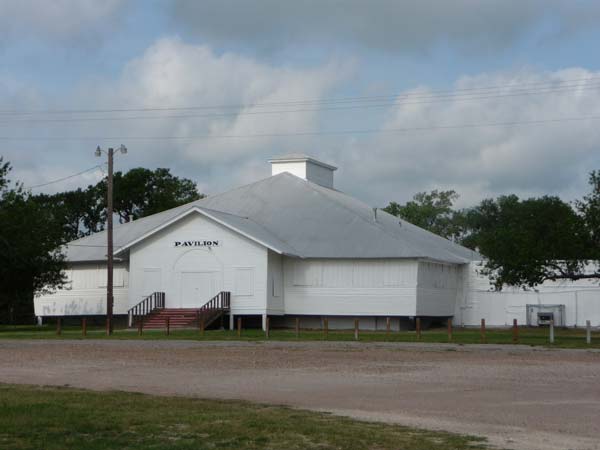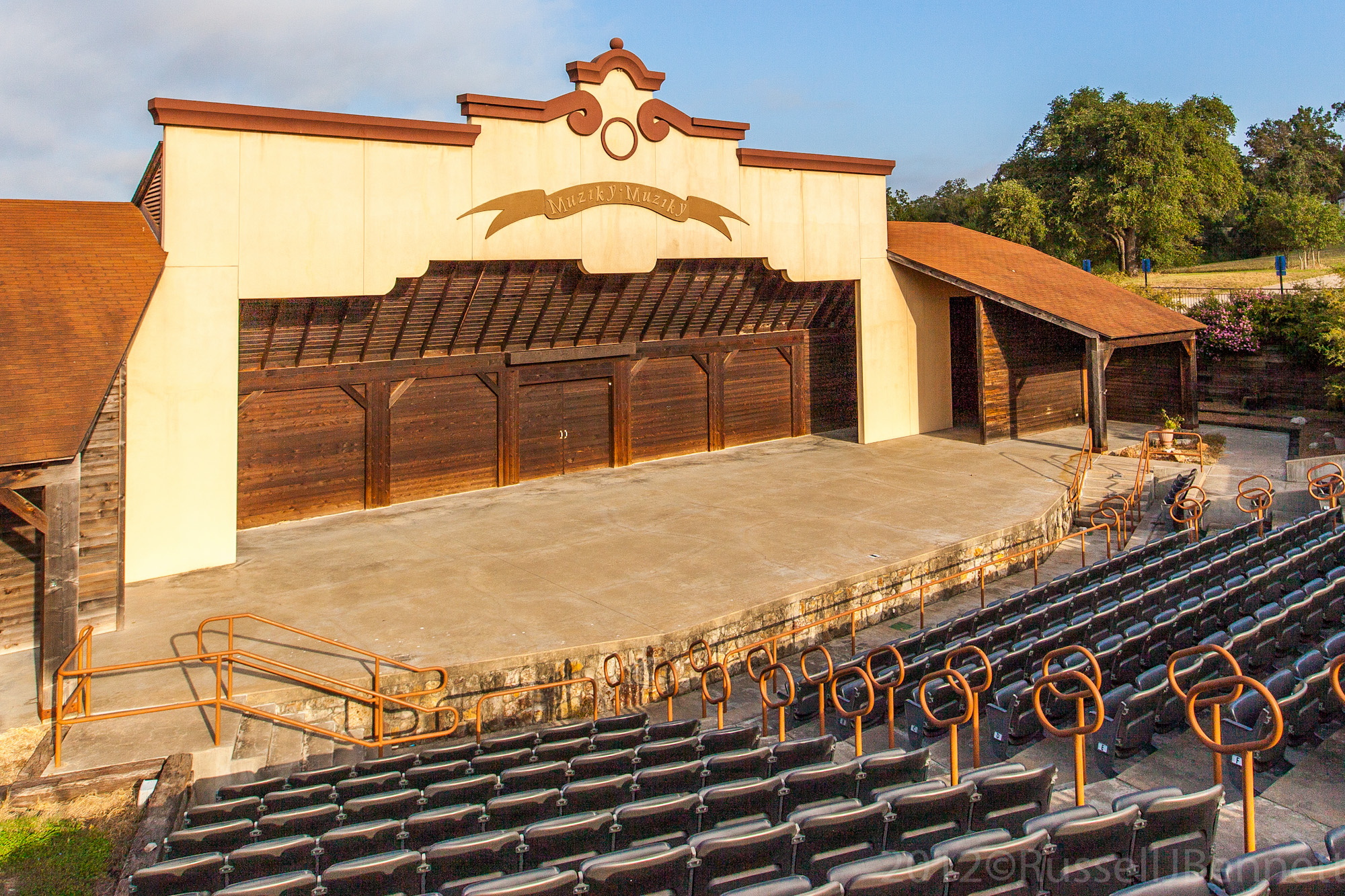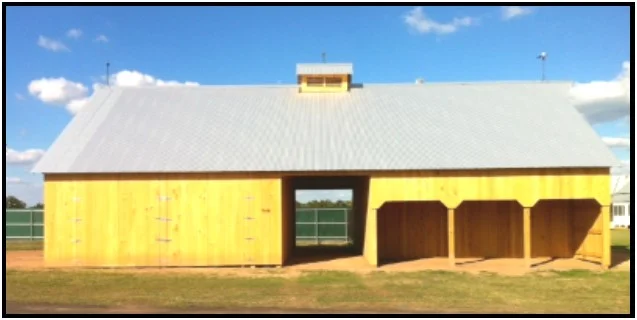Tours are welcome! Please schedule in advance for groups of 10 or more. Learn more.
Or take your own tour with this Self-Guided Tour Brochure
TCHCC Main Center
The Kolíbá Lobby invites visitors in to the TCHCC Main Center/Office/Library/Museum/Archives building which houses the offices, Hanslik Hall Dining & Meeting Room, the Willie and Mardi Kopečky Gift Shop, KJT Conference Room, the Bill and Betty Melnar Library, where genealogy and historical research can be accomplished, and the Nás Nový Domov (Our New Home) Museum, which displays the many artifacts and memorabilia that have been donated to TCHCC and tells the story of the early Czech-Texans. This Main Center building, designed by architect Roger Kolář, was completed in October of 2009. The building has a contemporary glass entrance representing the beacon of light that attracted the settlers to Texas and also brings to mind the 19th century farm houses, halls and buildings, but is not a duplication of them. At the entrance, paving stones, brick memorials and the Immigrants’ Wall honors family and friends. A memorial brick walk leads to the three flags which our Czech ancestors treasured: the United States Flag, the Flag of the Czech Republic, and the State of Texas Flag.
SPJST Lodge 19 Velehrad
The Lodge was moved from its original site in northern Lavaca County in the Velehrad community to TCHCC on Novemnber 9, 2017 by Káňa Brothers, Inc. Beginning in the spring of 2018, SPJST Foundation directors started making repairs. By the end of 2018, the building was ready to be painted both inside and out, including sanding and refurbishing the longleaf pine floor. Efforts were made with the selection of paint colors and the refurbishing of the furniture to match the original condition much as it would have appeared in the summer of 1897 when SPJST (Slovanská Podporující Jednota Státu Texas) was established and Lodge #19, Velehrad received its charter as one of SPJST’s first 25 charter lodges. The Grand Re-Opening of the Lodge at TCHCC was held on May 19, 2019. This celebration represented the continuation of the restoration efforts which commenced in 2002. In the spring of 2006, the exterior of the building was restored by members of the SPJST District 6 Cemetery Association. All three of these efforts contributed to rescuing this historic hall from obscurity. Read more.
Hluchanek-Salaš House
This house was donated and moved to TCHCC by Donald and Betsy Chovanec in 2008. Frank Hluchanek built this house in the Holman area of Fayette County in 1890. In 1915, Frank converted the old combination kitchen-dining room into a dining room and added a new kitchen. He sold the house to Anton and Mary Špaček Salaš in February of 1940. They updated the kitchen and added a bathroom in the enclosed porch. After moving the house to TCHCC, the kitchen and dining room was completely renovated. The added bathroom was torn out and the porch was renovated back to a wash room. The house was furnished and decorated to reflect the lifestyle of a middle class rural Texas-Czech farm family from 1890-1930s.
Sladek Smoke and Wash House
The Smoke & Wash house was funded by the children of E.A. & Frances Sladek of La Grange. It resembles many of the important out buildings of the time. The Smoke House was a vital part of living. Without electricity for refrigeration, meats were smoked and cured for preservation. The Wash House functioned as a place to wash clothes, wash and can vegetables, and store canned foods along with other important household necessities when houses only consisted of the main rooms.
Migl House
The Migl house was constructed in 1890 by the family of František and Johana Migl, with additions made in the 1920s. In 2000, Jim Jasek, one of the Migl descendants, obtained ownership of the house and donated it to TCHCC. The Migl family restored the house and moved it to the current site. The house displays Migl family memorabilia along with authentic furniture and items, and is maintained by the Migl family.
Janak Barn &
Texas Czech Agriculture Museum
This replica of an original early 1900s barn was built in the fall of 2013. Funding was made possible by grants from Rita Huebner Janak, Sanford Schmid, and the City of La Grange Economic Development. The Barn also houses the Texas Czech Agriculture Museum and was dedicated in October 2014. The Janak Barn is an example of the productivity and prosperity for a Texas-Czech farm family. The displays tell about early farming practices and show how the barn was the center of the farm.
Fair Pavilion
The Fair Pavilion was first built in 1925 and over the years has served as an integral place for people of La Grange and the surrounding area to meet and enjoy themselves at dances and various types of gatherings. The Fair Pavilion was originally owned by the Fair Association, which subsequently sold the facility to the City of La Grange in 1935. The Round-Up Association, a non-profit organization which raised money to benefit the youth of the La Grange area, was the last to manage the dance pavilion before TCHCC took over management. The facility is available for rent.
Čzeský Noviny Muzeum Czech Newspaper Museum
The museum is a replica of an early print shop and tells the story of the many Czech newspapers printed across Texas. Also included in the museum is a Kluge printing press, Fairbanks-Morse 6hp 1-cylinder gas engine, and related equipment used to print those newspapers. A significant part of the history of the settlement of Czechs in Texas is the story of their newspapers. Their desire to communicate and stay abreast of the news resulted in the founding of newspapers in their communities and in their Czech language. Some lasted only a few years, but others continued and eventually became newsletters or journals written in the English language. The press and type were part of a print shop in Iowa that printed the first Czech newspaper in the US and were donated to TCHCC in 2005 by John Kuba after he inherited the shop and equipment. Adolph Nový and crew moved the equipment to Ennis, TX where it was cleaned and repaired. In the spring of 2018, construction began on the museum with an initial donation from the Richard & Molly Černošek Family. The museum was completed in the fall of 2018 and displays were completed just in time for the March 16, 2019 dedication. With the help of volunteers, the shop now comes alive with motion and sounds when the engine and press are running.
Wallachian Bell & Belfry
In 1995, the Czech Republic participated in the annual Festival of American Folklife in Washington, D.C. Materials were transported from Roznov, Czech Republic to erect the belfry at the festival site. The bell was cast in Halenkov, Czech Republic especially for this occasion by Josef Tkadlec. The strong friendship between Victor Peter of Houston, a trustee of the Czech Heritage Society of Texas, and Dr. Jaroslav Stika, Director of the Wallachian Open Air Museum in Roznov pod Radhostem, led to the Czech Republic's decision to give the bell and belfry to the heritage society. CHS then donated the belfry to TCHCC, and the belfry was placed on the grounds in 2003. In 2014, the bell was removed from the tower, cleaned, and placed in a showcase in the TCHCC Melnar Library for viewing. A replica bell was then hung in the tower.
Krasna School Bell
DEDICATED TO CZECHS FOR THEIR EARNEST DESIRE FOR LEARNING AND PURSUIT OF EDUCATION BELL DONATED BY HONORARY CONSUL GENERAL RAYMOND SNOKHOUS AND CLARICE MARIK SNOKHOUS 2014
In 1891, Francis Smith subdivided and sold property in the Wallis area. In 1892, he gave four acres for a school and church for Czech settlers forming the community of Krasna, which means beautiful in the Czech language. That year, local families built a school, and in 1893, it became part of Orchard Common School District. By 1894, it was part of the Krasna District, which included Connersville School for African American students. Two additional schools, Moravia and Central, were later built. Flooding and storms caused a decline of the settlement, and the Catholic Church at nearby Wallis (Austin County) attracted settlers; there was never a church at Krasna. Read more.
Kalich House &
Czech Music Museum of Texas
Development of TCHCC began when the Kalich House, restored by volunteers, became the first TCHCC Visitors’ Center. This historic 1890s Texas-Czech farmhouse was donated by Peggy Kalich of Schulenburg. The house was moved to the site on June 22, 2000 by Káňa Brothers, Inc. House Leveling and Moving and then transformed into the Visitors’ Center, which temporarily housed the office, gift shop, library, and display area.
The restoration efforts took approximately 3,109 hours with some 80 volunteers ranging in age from 2 to 80. Major restoration of the roof and porches was done by Robert Slovak Construction and volunteers from Ennis. It served as the Visitors’ Center until 2009 when the main building was completed.
It is now TCHCC’s Czech Music Museum of Texas displaying music memorabilia in four musical genres: Classical Music of Czech Composers, Spiritual/Liturgical Music, Folk Music and Dance, and Polka/Czech Brass Music.
Hospoda (Tavern) & General Store
The main building was donated by Roy Buček of Schulenburg and a side room for a general store was added on by volunteers. A tavern/store was the center of early Texas-Czech communities where immigrants would meet, get mail and information of the outside world, have a pivo (beer), and purchase necessary staple goods.
Hoelscher Haus &
Polka Lovers Club of Texas Museum
The Hoelscher Family immigrated to Texas from Olfen, Germany in 1846. This haus was built in 1880 by Anton and Elizabeth Bruese Hoelscher as a bedroom/parlor addition to their original house. In October 2005, Esther and Henry Hoelscher of Houston made a gift of the Hoelscher Haus to the Polka Lovers Club of Texas Museum (PLCTM), and it was moved to the TCHCC grounds. The haus is of the salt box architecture with a long porch across the front, two rooms on the lower floor for displays, and two rooms upstairs for storage, exhibit preparation, and office space.
The mission of the PLCTM is to provide a facility for the preservation of the history of polka music, song, and dance with displays of memorabilia associated with the Polka Lovers Klub of America Texas Chapter.
In February 2016, PLCTM officially dedicated the Msgr. Joseph M. Hybner Center, which was built to provide additional space for displays, meetings, and events. The Center was named after Father Hybner of Shiner, polka lover who can often be seen at area church picnics singing along with the Czech bands. Read more about PLCTM. The Hoelscher Haus can be viewed by appointment only.
Zapalač Sawmill
This 1895 De Loach No. 1 Mill was owned and operated by the Vinc B. Zapalač family from the Ellinger area on the Colorado River in Fayette County. Donated by Donna Zapalač Mueller, the mill represents the industrial businesses and entrepreneurship of the Czechs. The restoration project was funded by a grant from the Dickson-Allen Foundation along with various versions of help from others. The mill restoration was completed in 2015, and is a working original maintained by the South Texas Wheel Spinners & Crank Twisters Antique Farm Equipment Club. The display also showcases early life on the Zapalač family farm. The mill is operated at the May Fest and Heritage Fest each year and on school tours.
Log Crib
The authentic circa 1904 double-log corn crib with dog trot was constructed with hand-hewn logs joined with simple saddle notching. A central passageway allowed for easy loading/unloading of wagons to or from a crib on either side. The Log Crib was donated by Hilda Fajkus and Sylvia Ratcliffe of Cistern. It was moved to the site by Káňa Brothers Moving Company and restored by brothers Ed, Ernest, David, and Robert Vašek of Plum, and Robert Stall of Smithville with replacement logs donated by Vickie Matocha and Jeb Pape.
Sanford Schmid Amphitheater
Thanks to an initial grant by the LCRA and a matching grant by La Grange resident Sanford Schmid, the amphitheater was built in 2000. The 5,500-square-foot facility is built in a Texas Czech style and includes an open stage, dressing/meeting rooms, restrooms, and prop storage area. Music is very special in the life of Czechs. The Czech saying Muziky, Muziky (Music, Music) adorns the top of the stage. The facility is available for rent and used for musical performances, theatrical plays, presentations, and outdoor weddings. Muziky, Muziky performances are part of the Czech Heritage Festival held each October.

